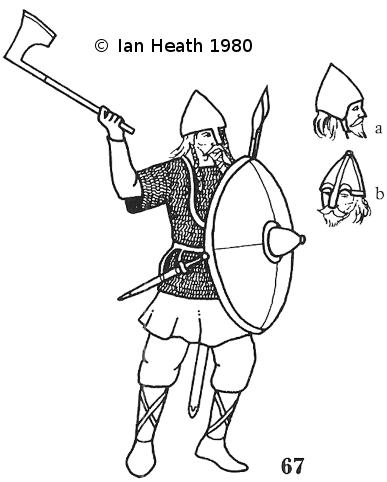
67. VIKING HIRDMAN OR HUSCARL
An extract from Armies of the Dark Ages 600-1066by Ian Heath

67. VIKING HIRDMAN OR HUSCARL
He wears a short mail corselet and a helmet of the most common variety, conical with or without nasal. 67a shows a variant from a picture stone with a chin-strap and sides extended into ear-guards, and 67b another variant with eyebrow ridges as well as nasal. Mail aventails and, later, coifs, were also worn. Archaeological evidence indicates that lamellar was sometimes worn in Sweden at least.
He is armed with sword, knife, characteristic one-handed bearded axe (in use by the 8th century) and 2 light javelins which are little longer than arrows. Swords were generally of Frankish origin since their own lacked flexibility and tended to break-in use. The scabbard was often suspended from a baldric.
The baggy trousers shown here can be seen quite distinctly in tapestries and picture stones and were of steppe origin. Clothing colours popular amongst the Vikings included red, scarlet, red-brown, brown, blue, green, white, black and grey, the last particularly for cloaks; red, leaf-green and blue were favourites, the Dublin Vikings having a particular preference for red. Trousers were sometimes striped vertically, and one anecdote records that leggings should be brown or any other colour except scarlet. Cowhide or sealskin boots might also be worn, hairy side out.
The Vikings were vain about their appearance, bathed and changed clothes regularly, and may have even worn eye make-up! All Vikings wore beards, which were looked upon as proof of their masculinity; this man has his plaited. Hair was likewise often plaited and could be grown to considerable length — that of Brodir, one of the commanders at Clontarf, is supposed to have been so long that he tucked it into his belt. Hair colours ranged from blonde and red to black, darker hair being more common amongst the Danes.
11th century Viking huscarls would have closely resembled the Anglo-Danish Huscarl described under 120 (though substituting a round shield, the kite-shield apparently not being generally adopted in Scandinavia until the 12th century); such longer mail corselets were clearly in use by the 11th century at the latest, Harald Hardrada’s being described in 1066 as ‘so long that it reached below the knee, and so strong that no weapon could pierce it.’